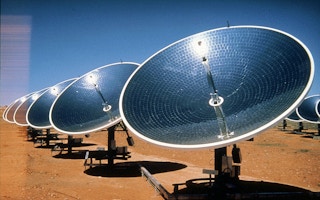White Cliffs might seem an unlikely location for history to have been created. What’s perhaps even more unlikely is that it could be recreated.
On the edge of the desert, 250 kilometres north-east of Broken Hill, this “Mad Max kind of place” played host in 1981 to what was claimed to be the world’s first commercial solar power plant.
Outdated by modern standards, the plant consisted of 14 large parabolic dishes, each made up of 2000 small mirrors, generating power via a steam engine.
Initially the experiment was to last just two years, providing much-appreciated power to a town off the electricity grid and relying previously on diesel and battery alone.
About 14 years later, the station was converted from solar thermal to photovoltaic, with the mirrors instead focusing the sun’s rays on high-performance solar cells.
With the grid finally reaching the town, the need for the solar power ended and the solar plant was decommissioned in 2004, its array of mirrors left to gather dust amid the mullock heaps of abandoned opal pits.
Now the NSW government wants to see if the plant can be revived, granting the White Cliffs Sporting Club $50,000 to explore possibilities of turning it into “a modern community asset”.
“White Cliffs was our first ever attempt at doing some good in Australia,” Keith Lovegrove, a former Australian National University researcher who worked on the plant. “You can accurately trace two direct links to current activities [in solar energy],” he said.
Speaking of the remote opal mining town, Dr Lovegrove describes it as a “sort of a Mad Max kind of place”.
“Strange home-made houses and junk everywhere, burnt-out trucks and cars with no doors - it’s brilliant.”
The grant is one of nine offered to community groups across the state, worth $411,000 all up, mostly for scoping studies or to identify obstacles to local renewable energy projects.
Pedigree, though, only goes so far. Even White Cliff residents reckon the government aid is more likely to fund a tourist attraction than a power plant.
“Realistically it’s really only its heritage value,” said Dick Wagner, a local organiser and part-time opal digger.
“We’re grasping at straws if we ever think we’ll be able to get it up and running.”
Dr Lovegrove, now an energy consultant with IT Power, found the mirrors on his recent visit to be “in reasonable shape” but unlikely to replace grid power.
“They probably could run it but it would probably cost them more to run it than it would make in energy,” Dr Lovegrove said.
As a solar concentrator, the original array of 14 dishes generated 25 kilowatts of power. One modern 500 square-metre dish today would produce 100 kilowatts alone.
“We wouldn’t want to build less than 10 dishes, maybe 100 dishes, to have a proper power station,” Dr Lovegrove said, noting commercial plants now run from 50-200 megawatt in size.
‘Diabolical’ location
Still, a spruced-up solar plant would be an added allure – along with colourful gemstones and an opalised fossil plesiosaur – for grey nomads drifting along what Mr Wagner called a “not too important road”.
To be sure, the road is better than the unsealed dog track it used to be. One ANU boffin called the town’s remoteness “diabolical”.
Storms can also be fierce with the university’s own record of the experiment noting tales of cars being “sandblasted clean of their paint during dust storms.”
The fact the mirrors have survived in even remotely workable conditions over the decades, though, may be another useful lesson from the site, Dr Lovegrove said.
Far horizons
The government’s other grants for community solar and wind projects may have more success.
The funding, though, comes within weeks of the cabinet’s decision on whether to formally accept tough guidelines on new wind farms that renewable energy advocates say will be among the toughest in the world.
While welcoming the community grants, Ashley Bland, a board member of the Central NSW Renewable Energy Cooperative, queried their value if broader regulations remain hostile to new wind farms.
“The grant is really fantastic,” said Mr Bland. His group will receive $60,000 to promote clean energy from the Blue Mountains to Broken Hill.
The co-operative, however, has been waiting two years for the approval of the Flyers Creek Wind Farm so that it can mobilise local support to buy one of the farm’s 44 proposed wind turbines for about $5 million.
“The difficultly is inspiring people to put their cash on the table without the approval,” Mr Bland said. “We can’t kick off our fund raising.”
Victoria pioneered community-owned wind farms with the development of Hepburn Wind Farm, north-west of Melbourne. All up, however, that two-turbine farm cost about $13.5 million to develop, with the Victorian government chipping in $1.75 million - four times the current NSW offering for nine projects.
“About $1 million was spent on legal and design work and securing all of the approvals,” Martin May, a former treasurer of the Hepburn project, said. “That’s just to get to the permit stage.”










